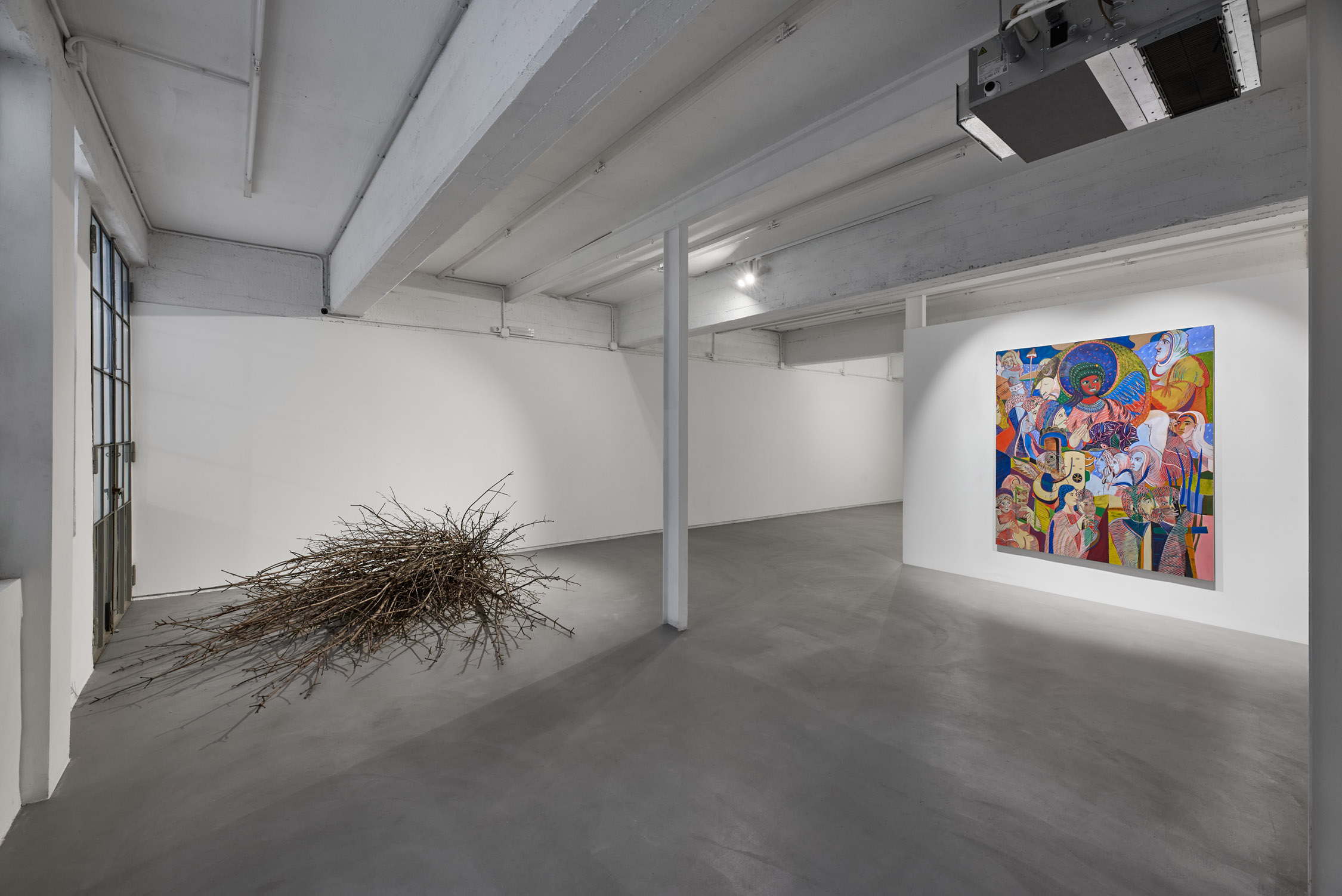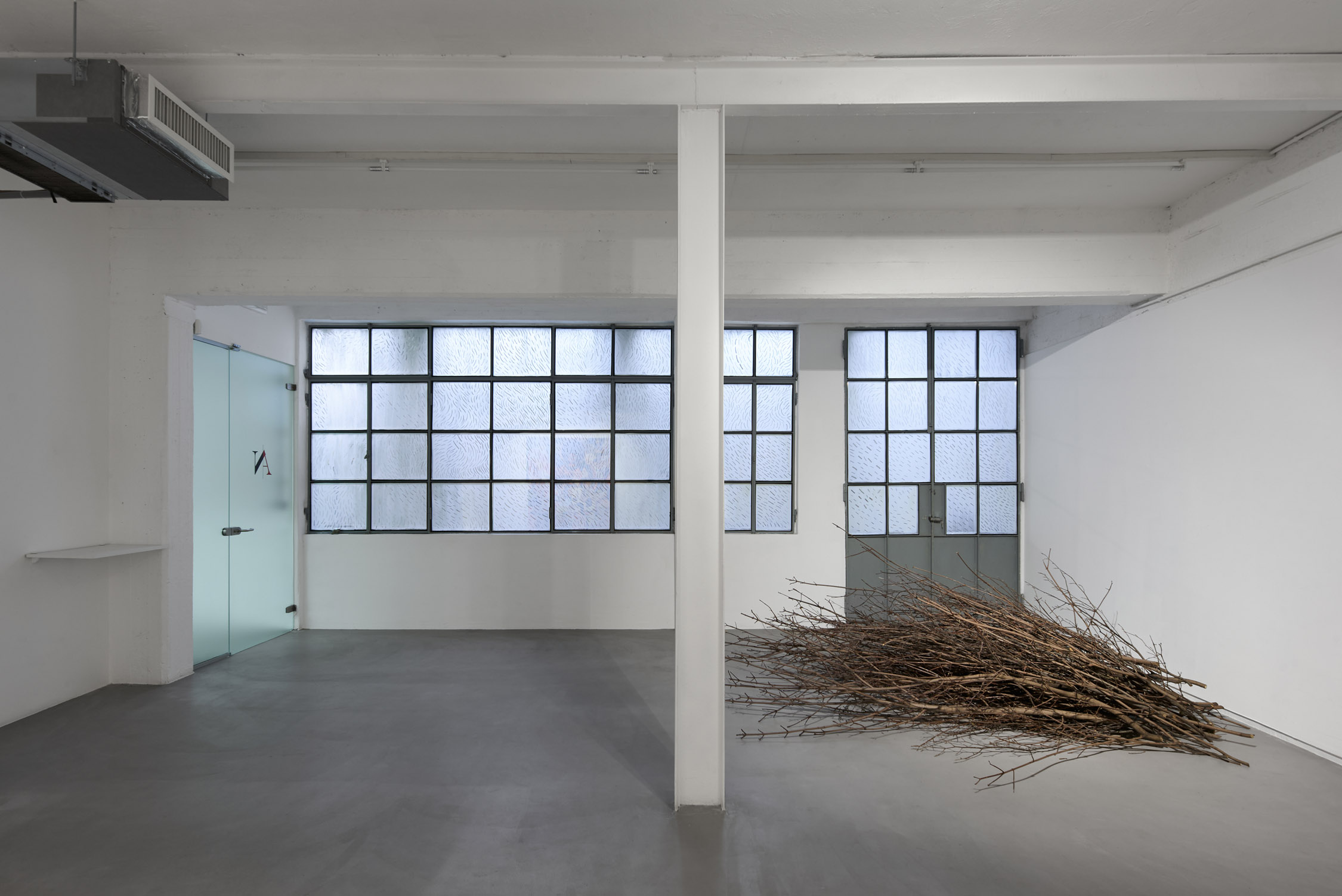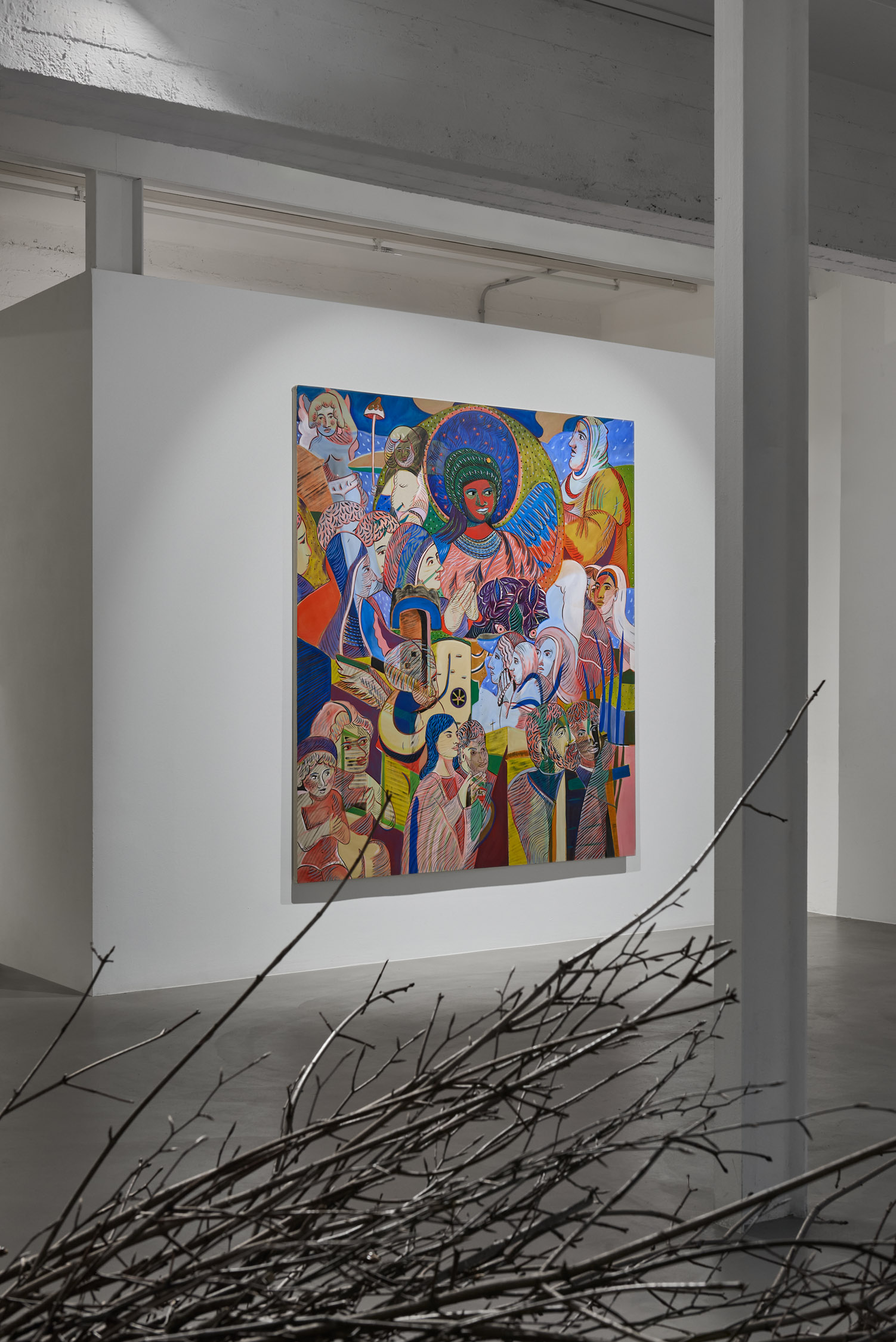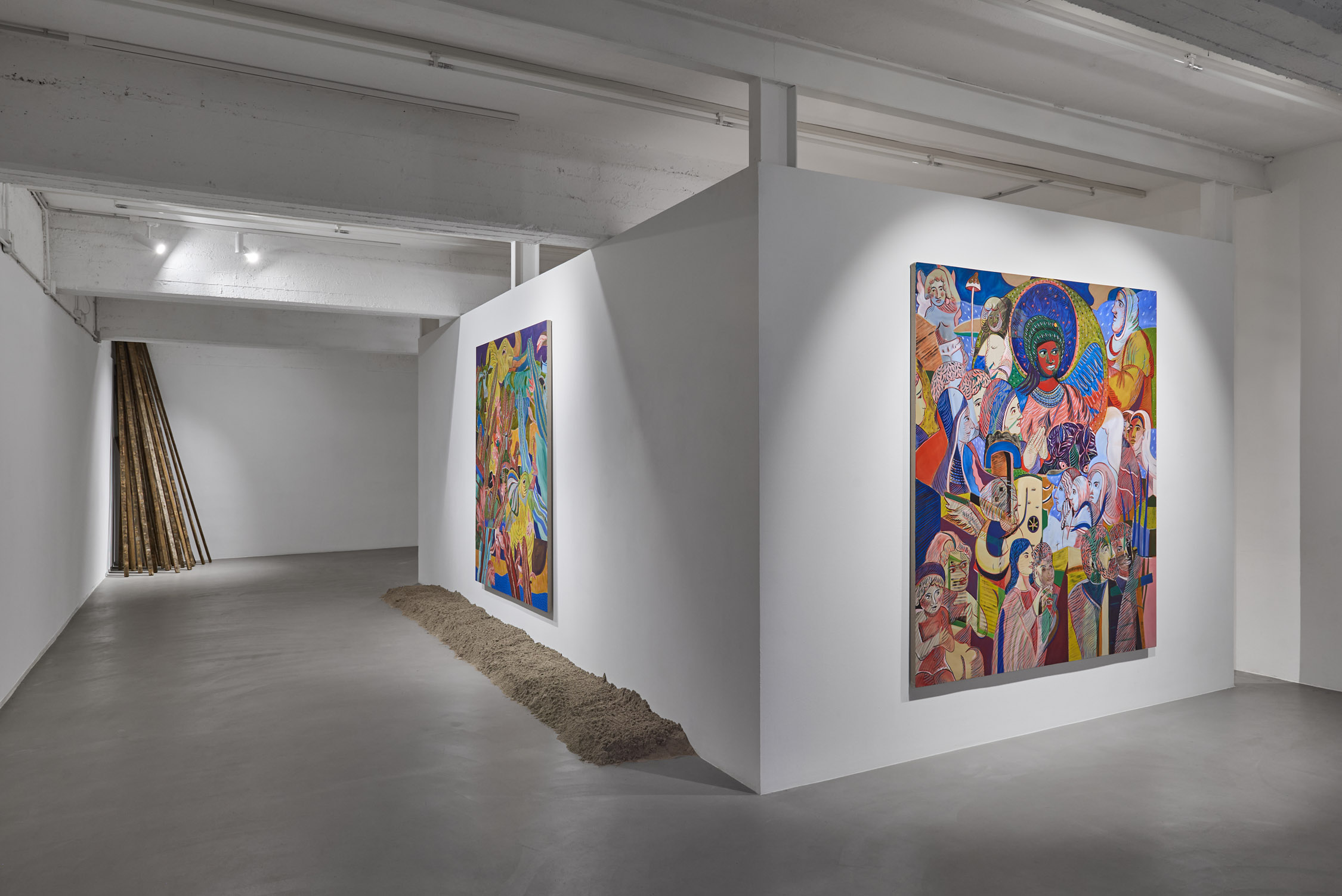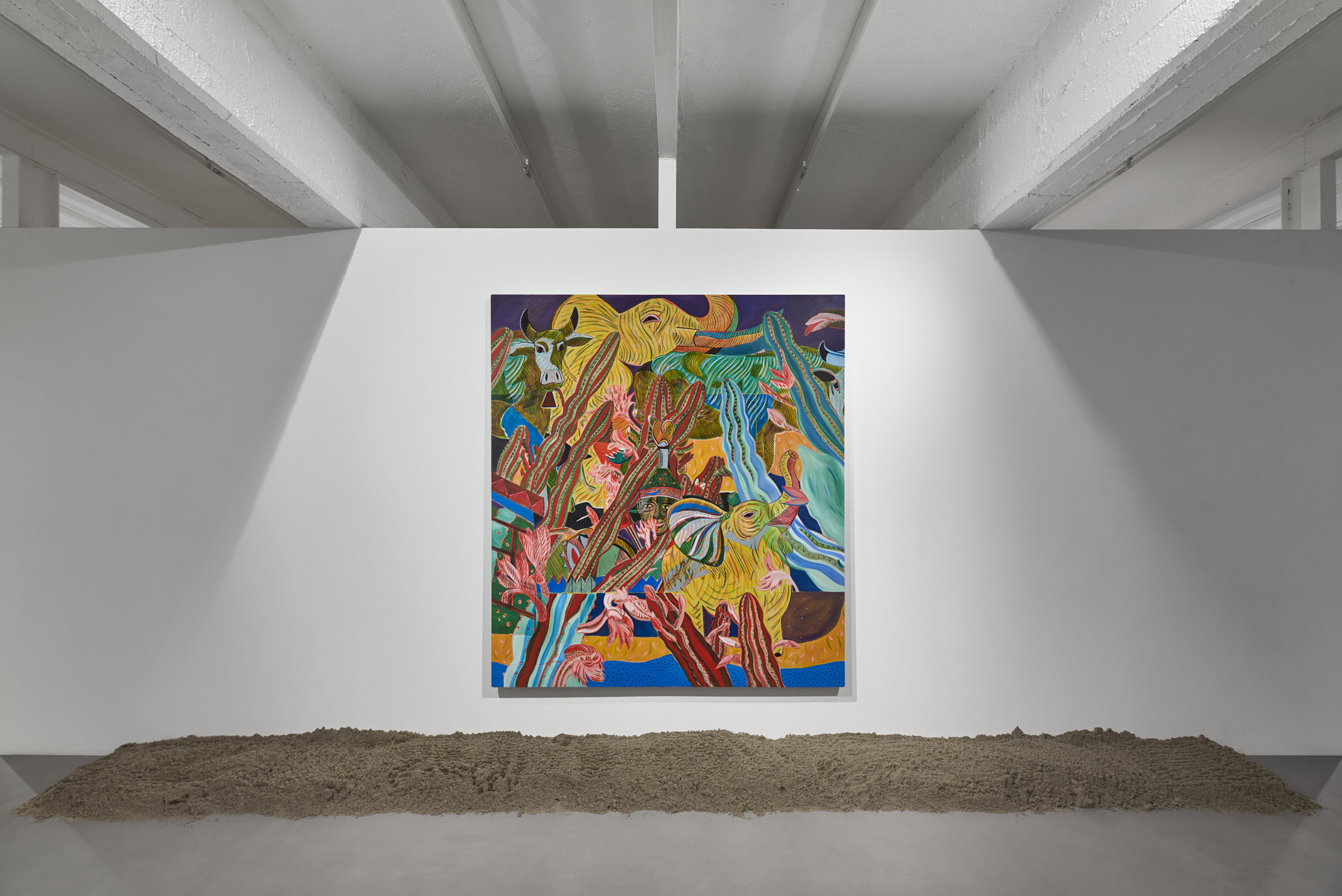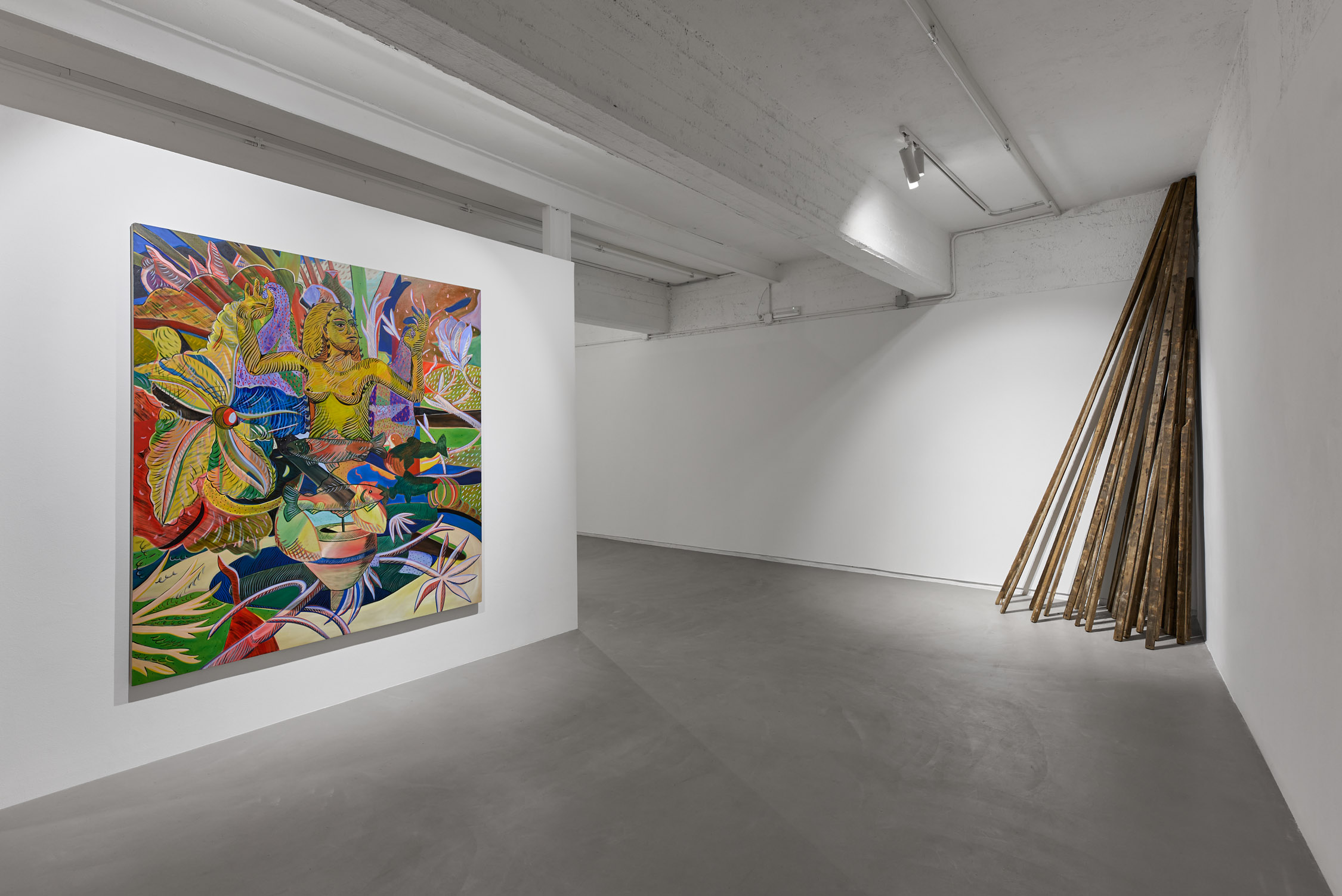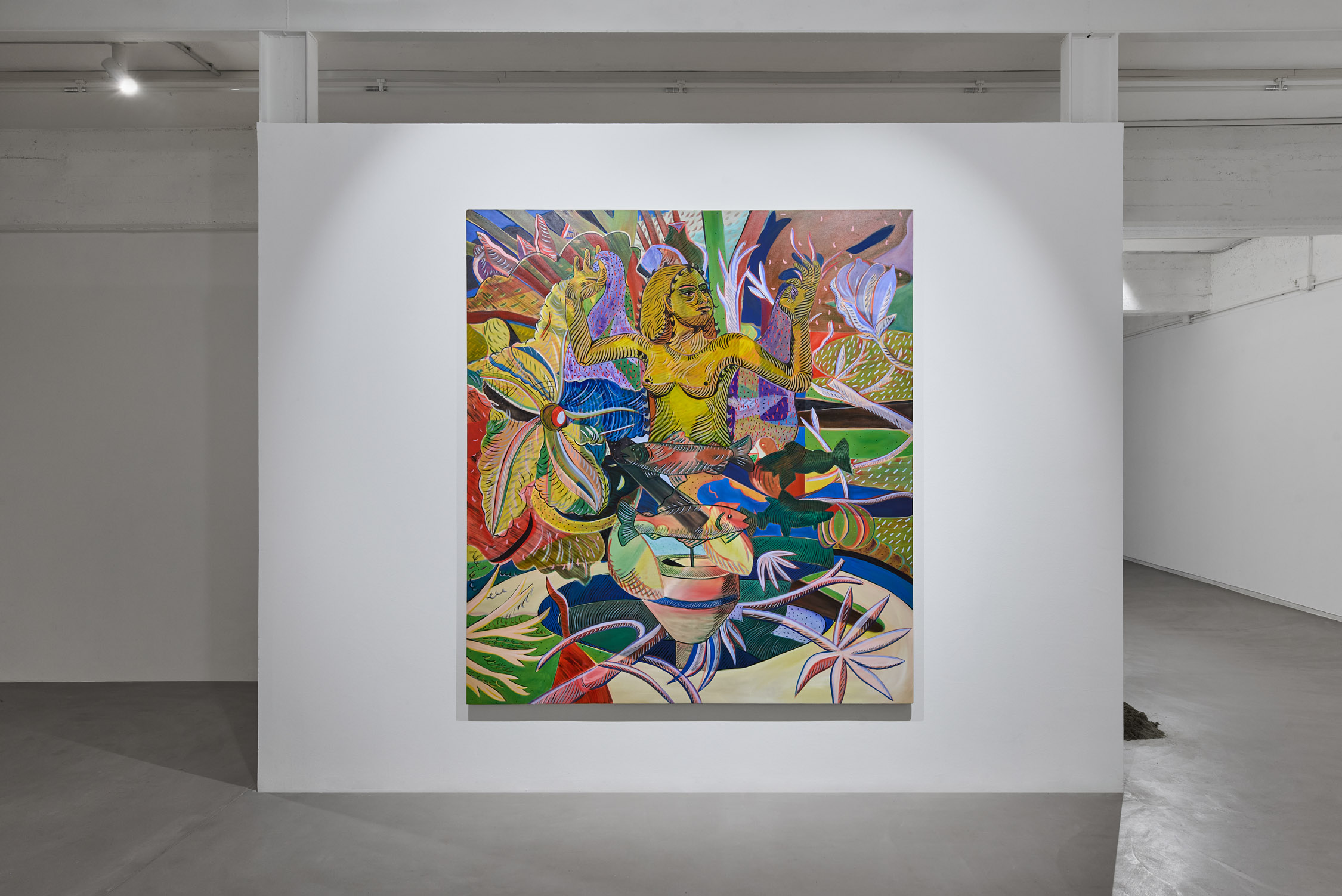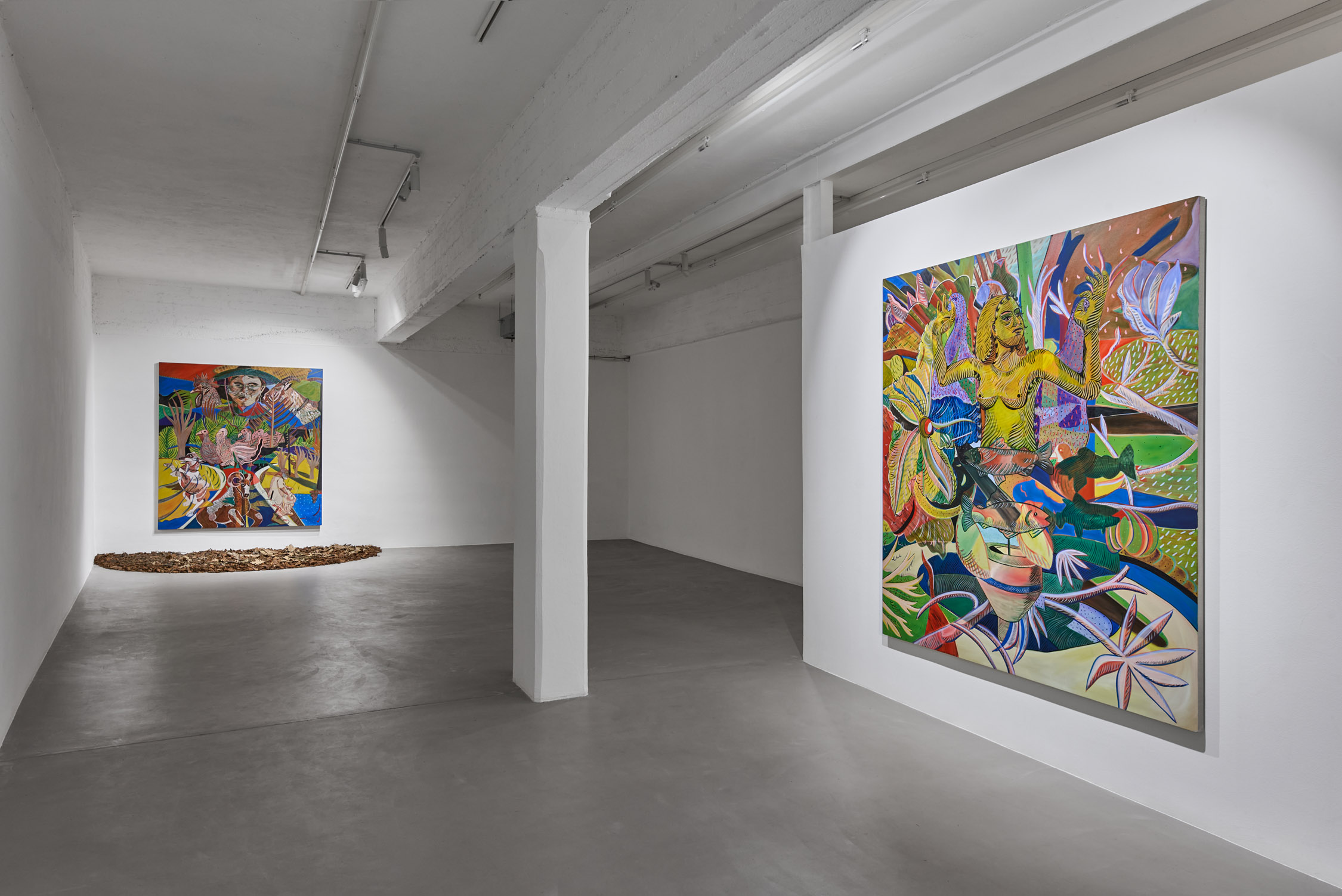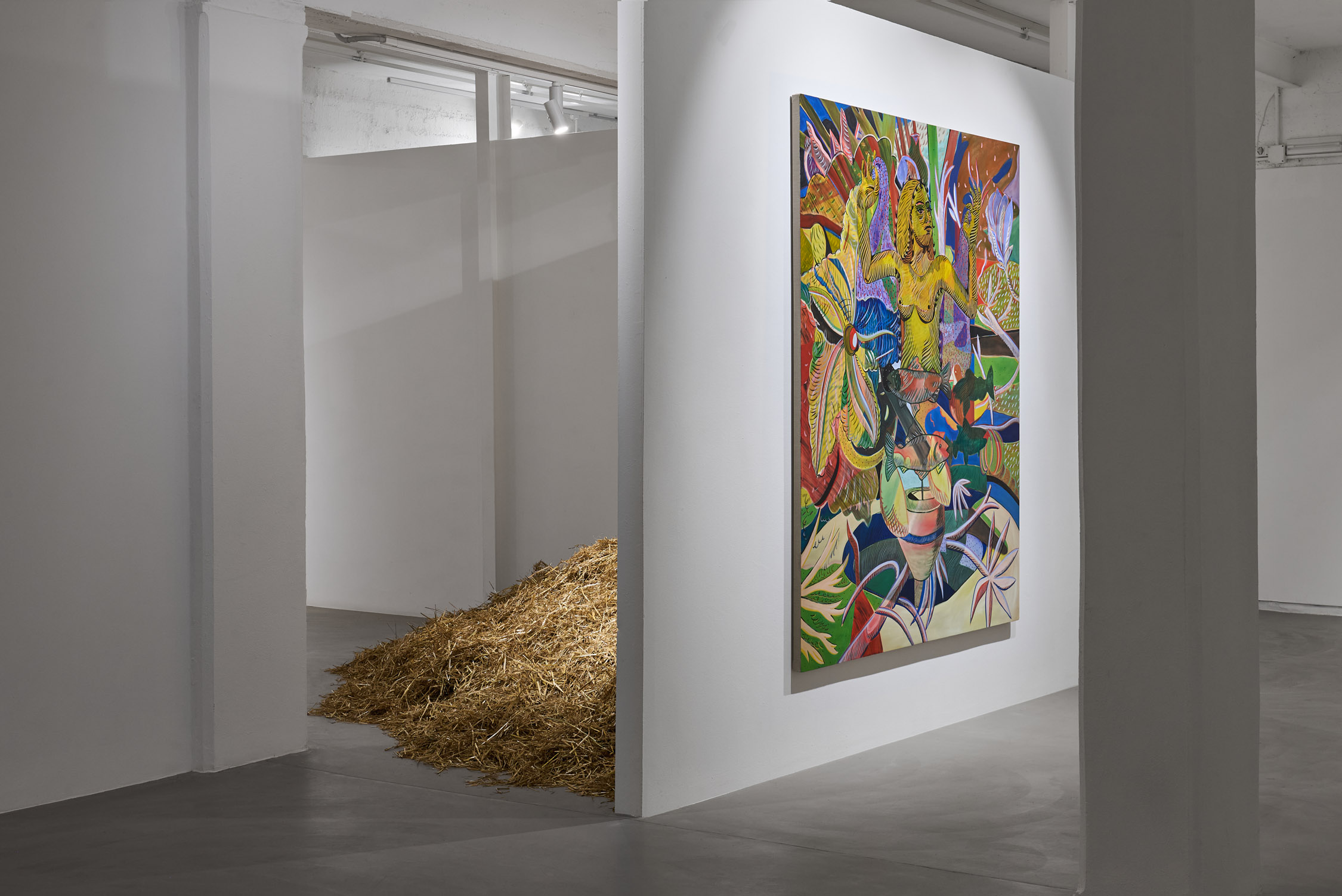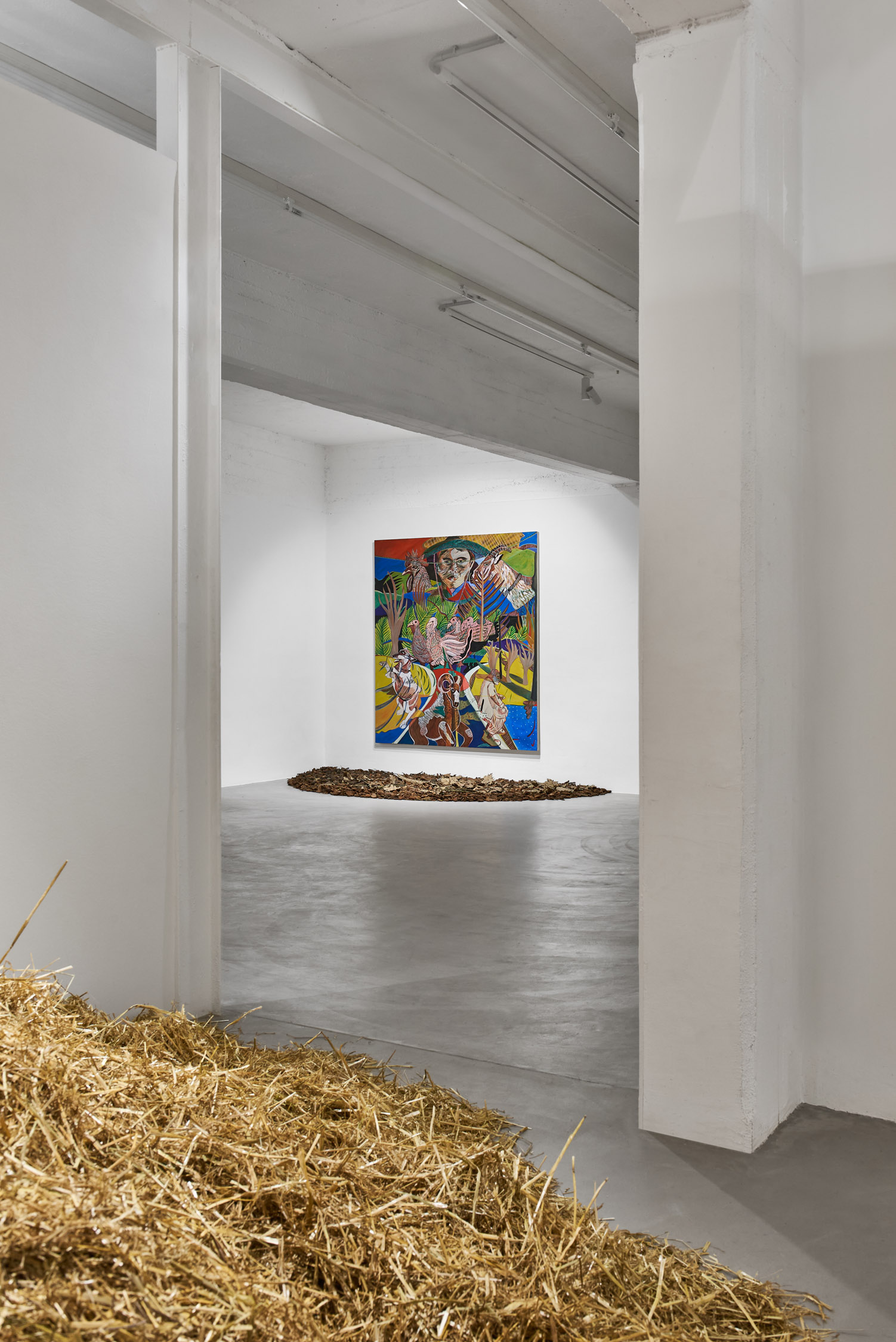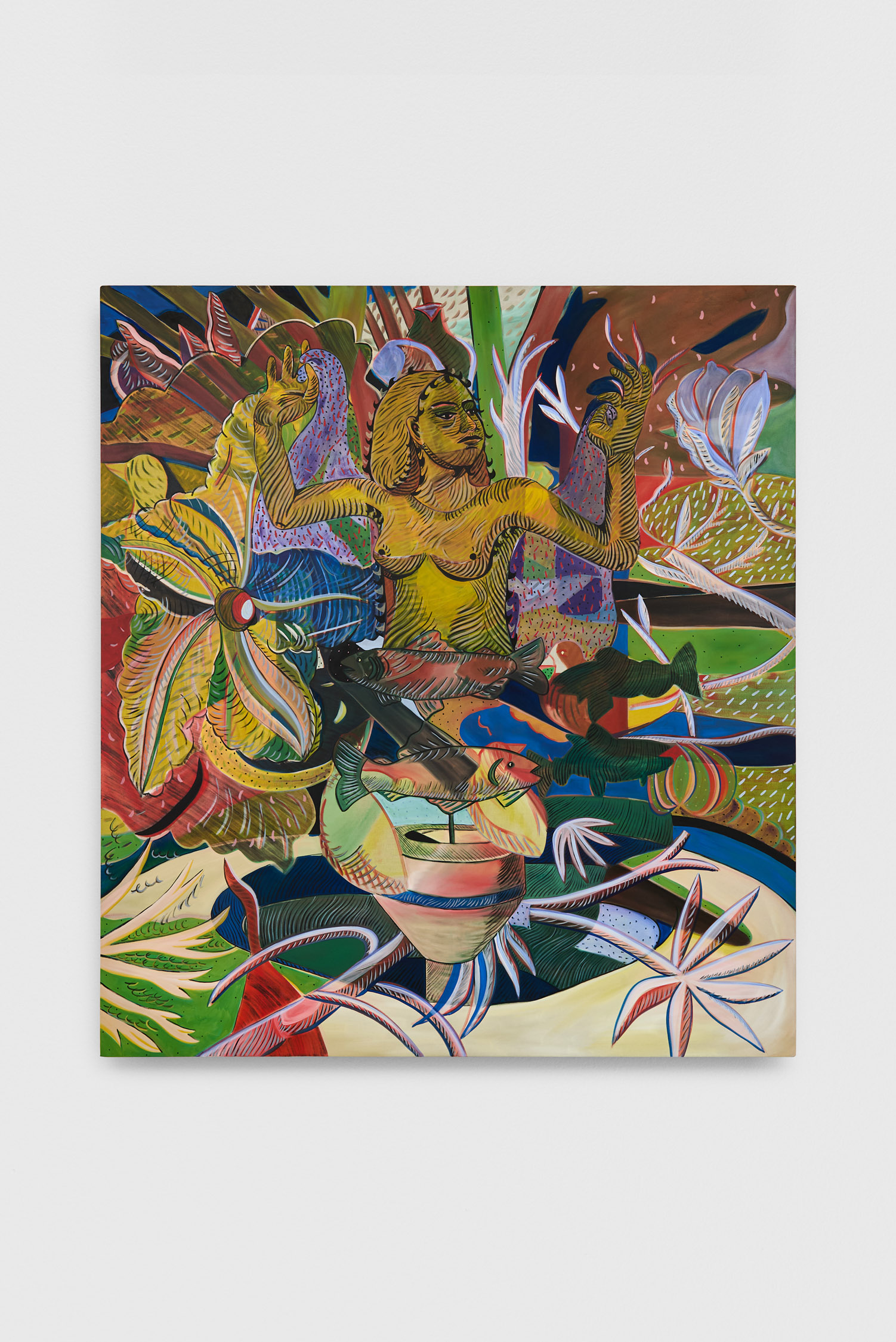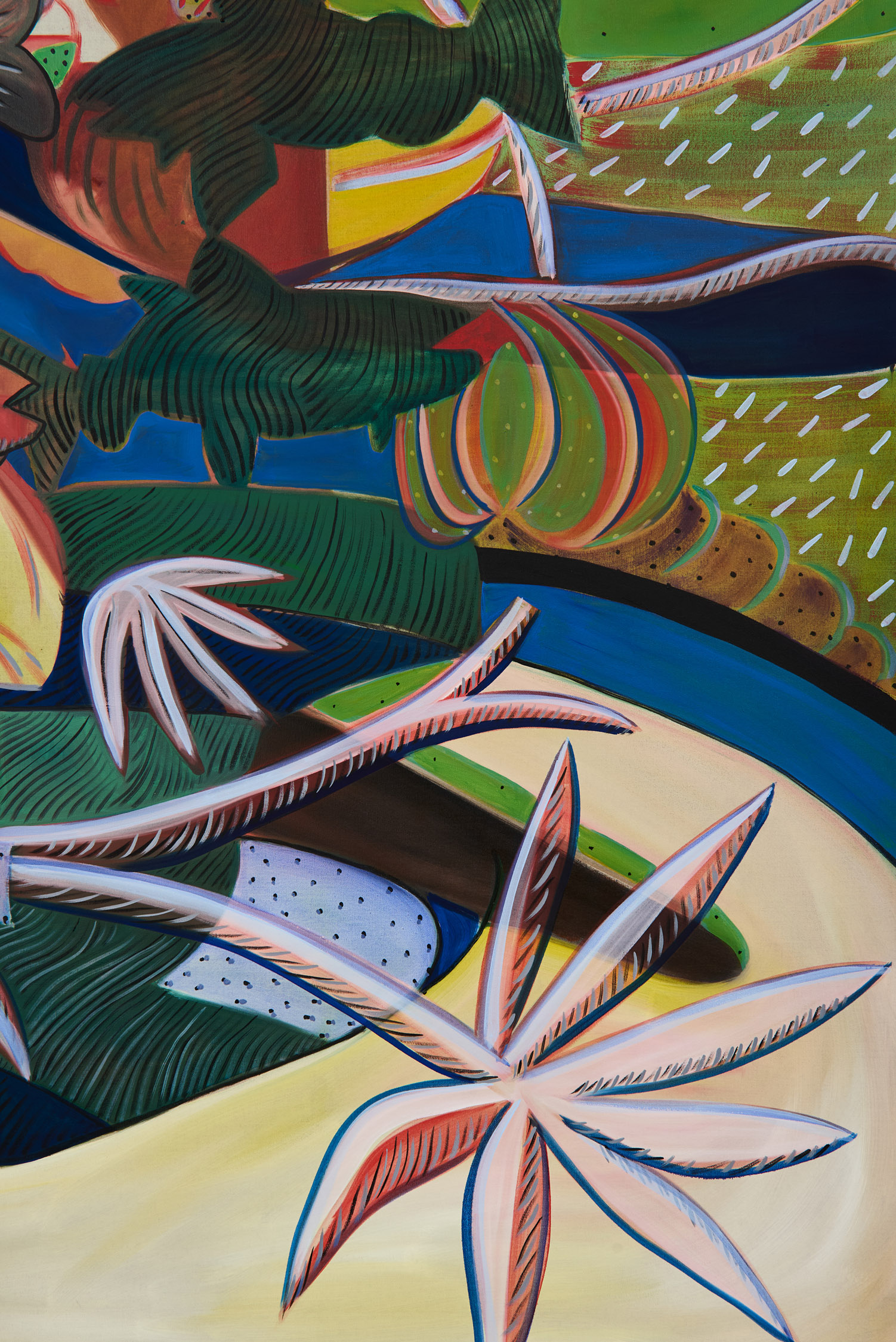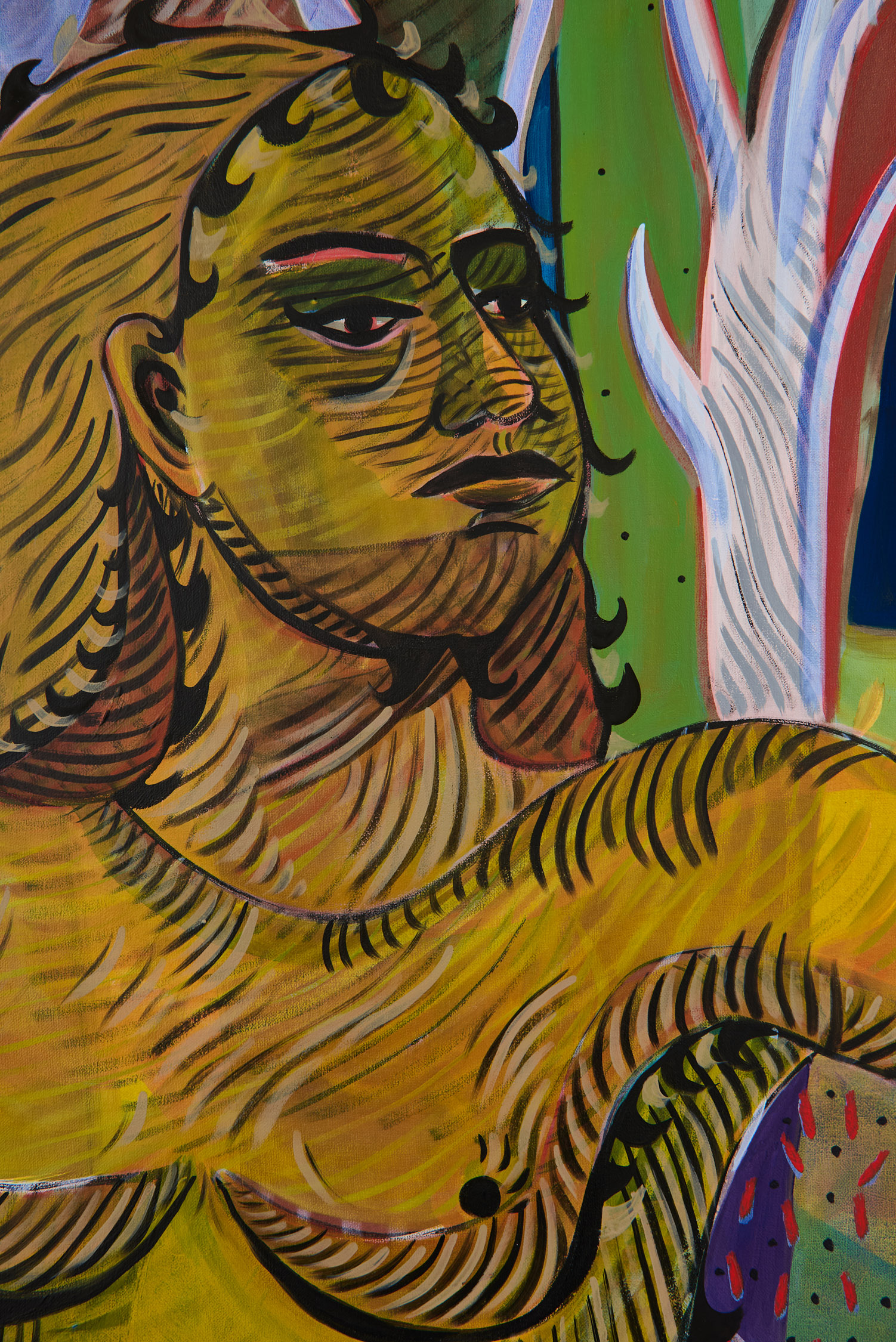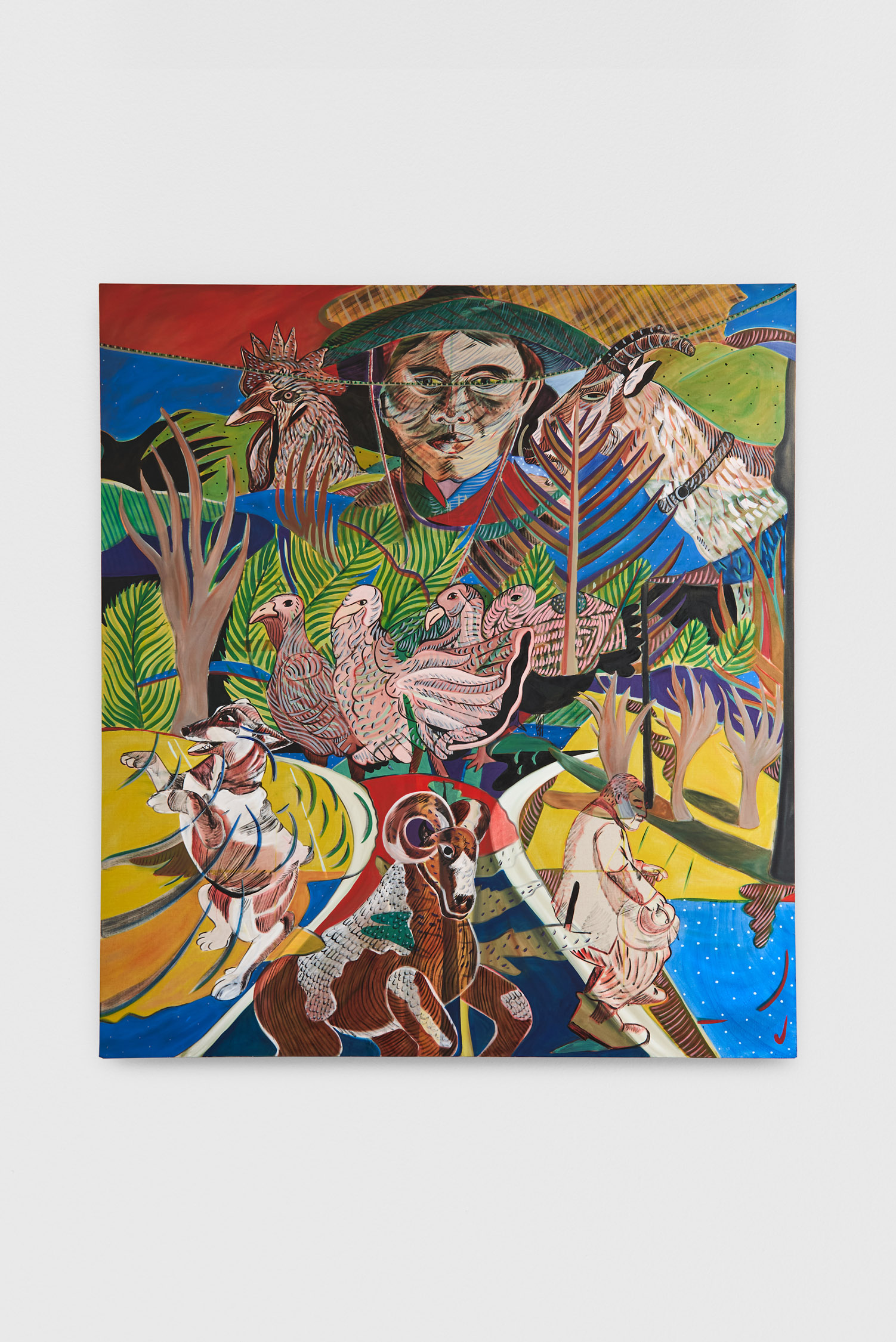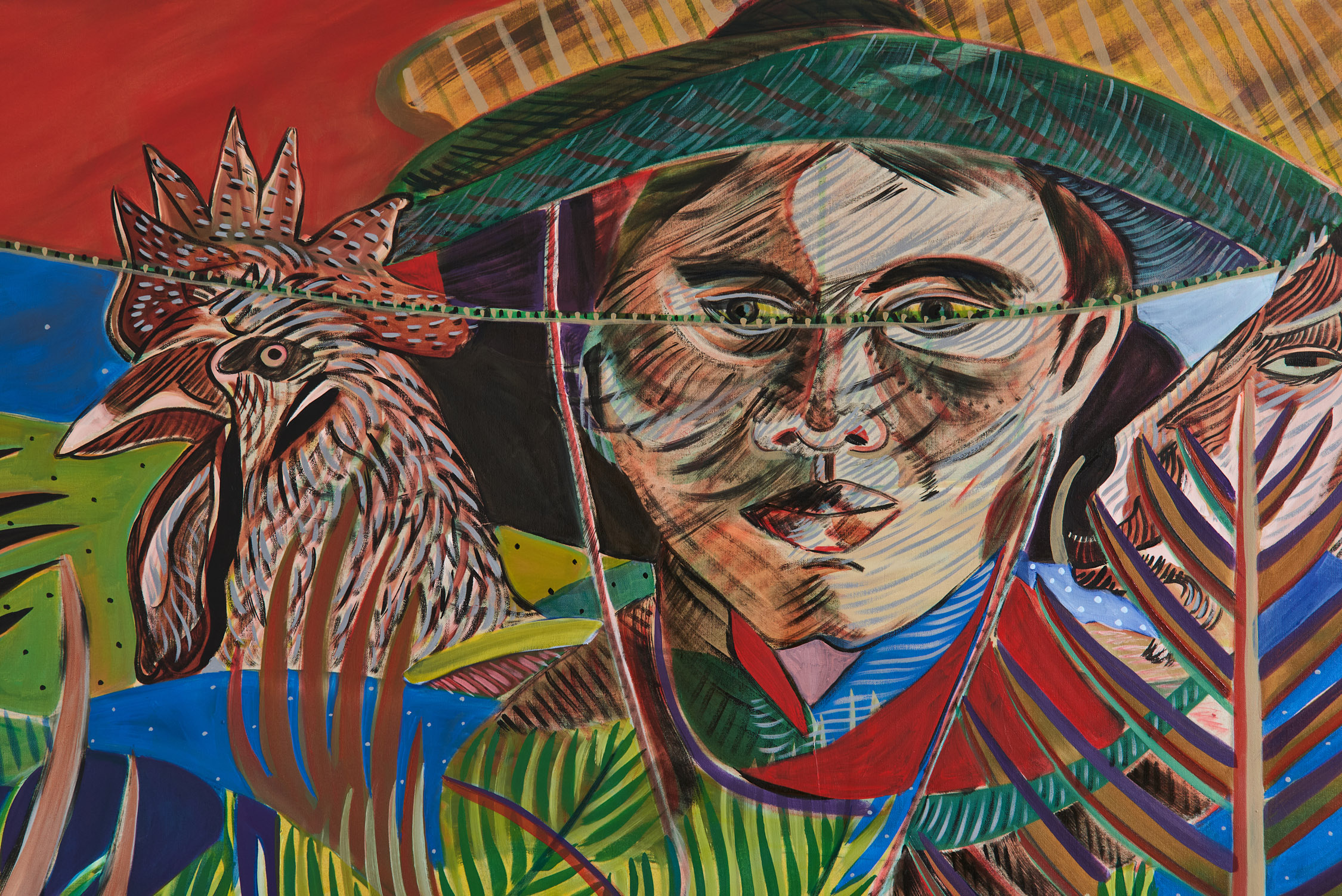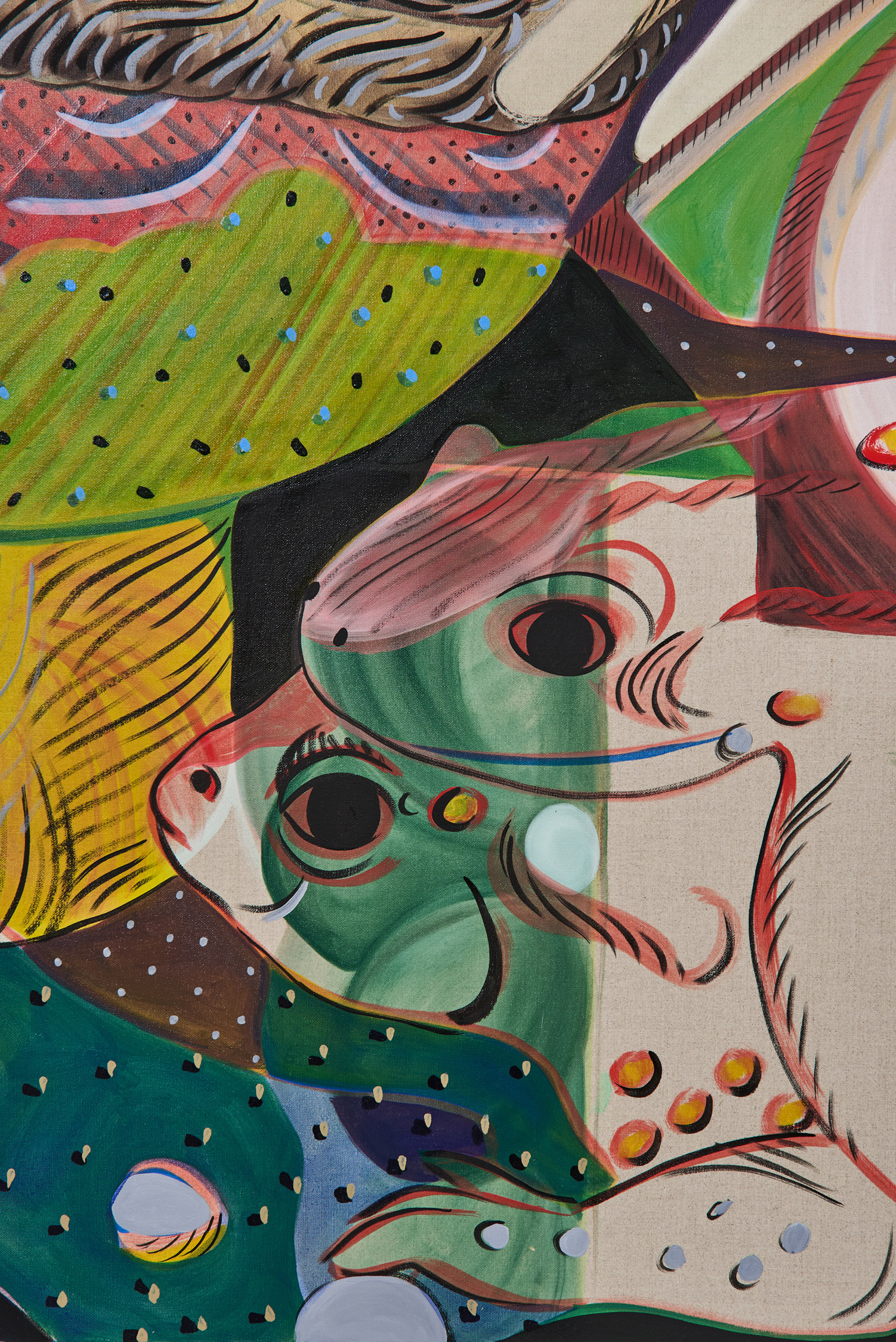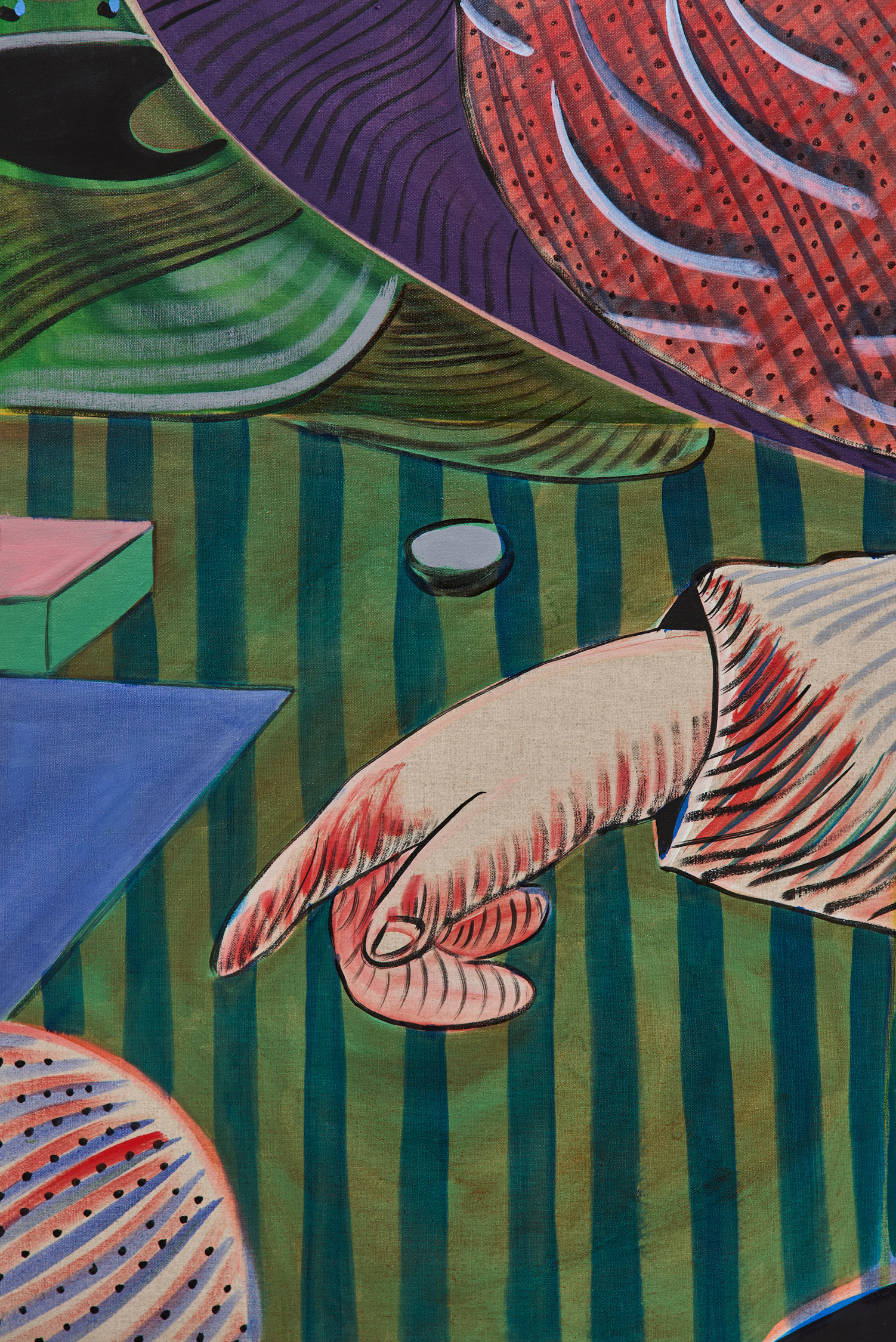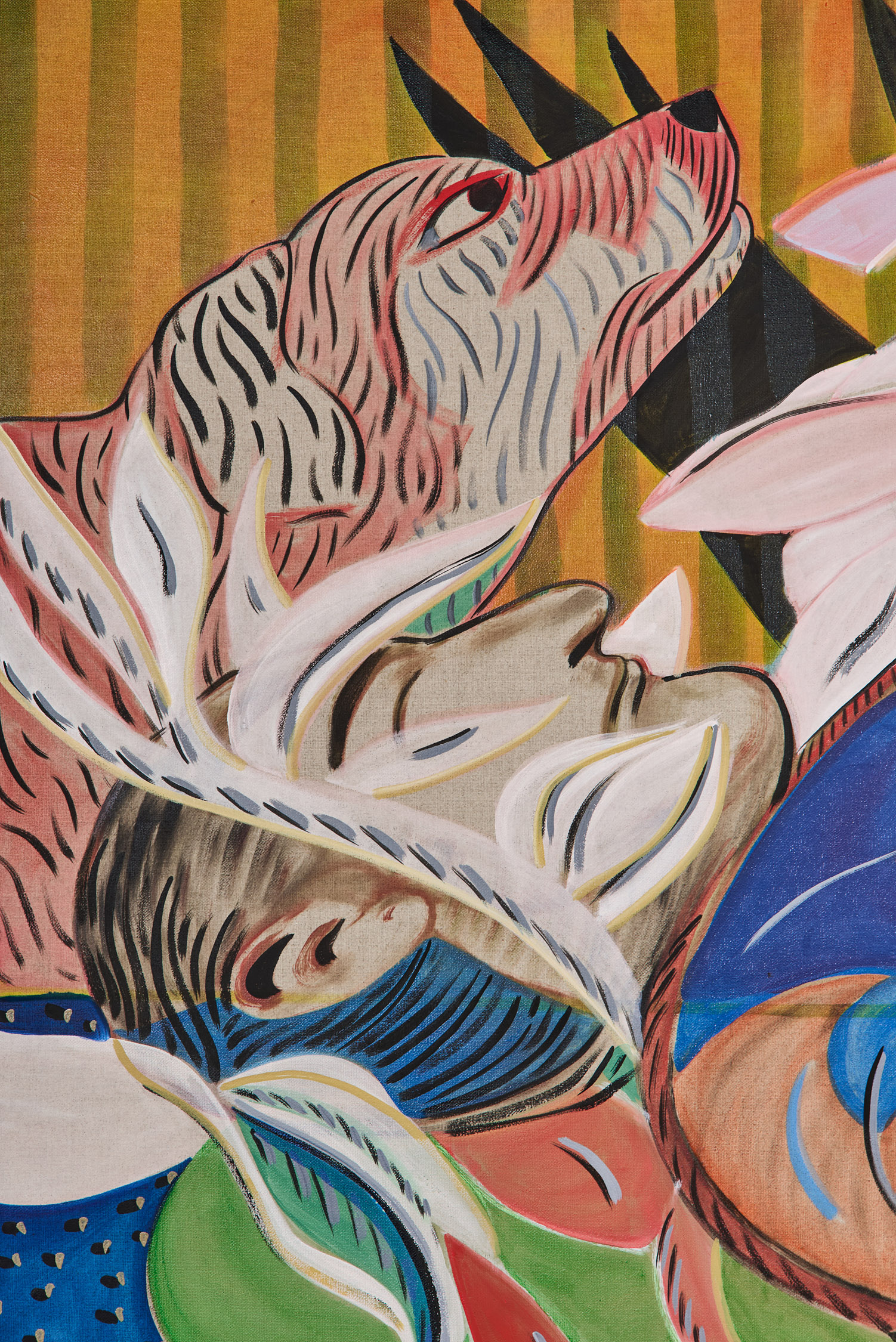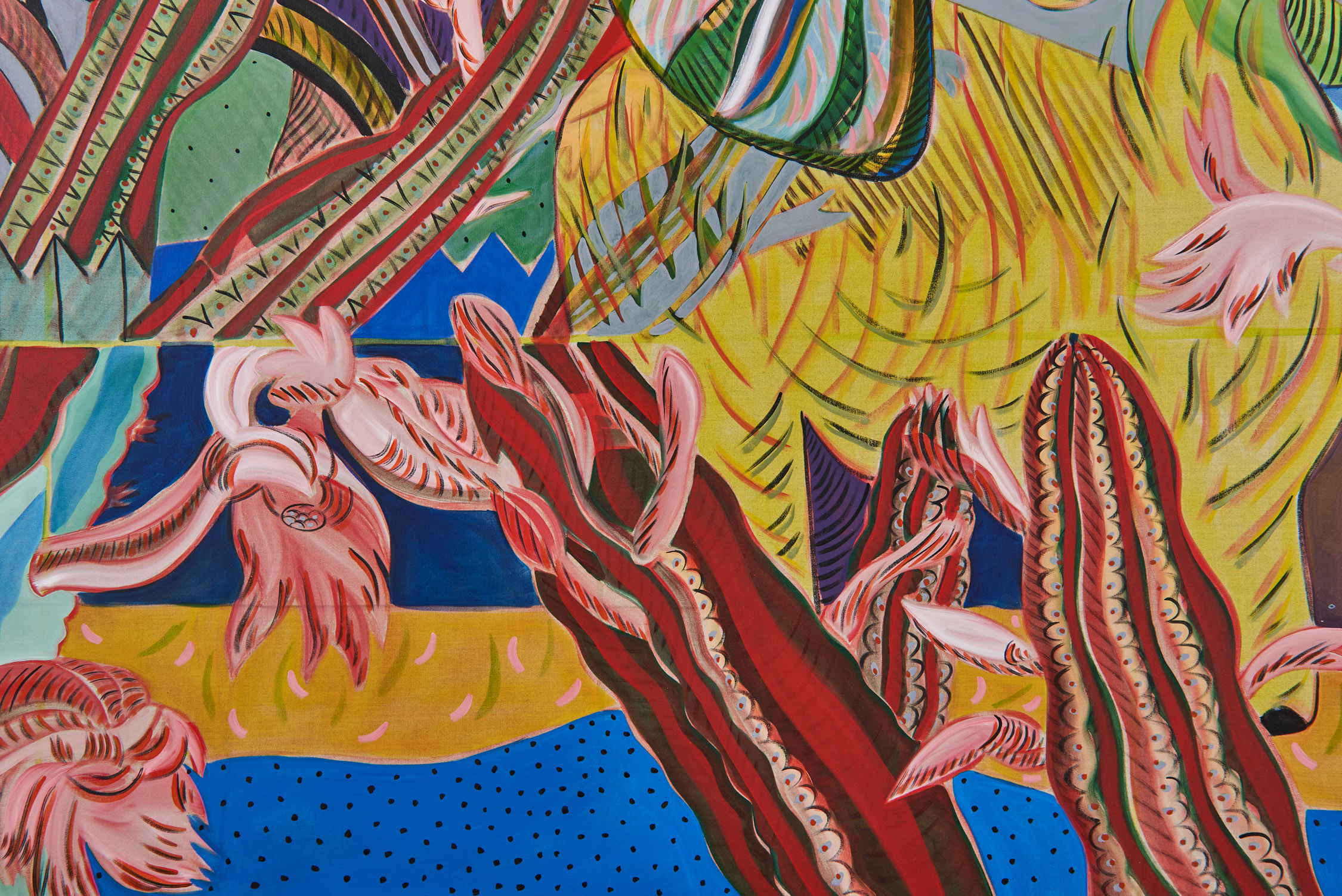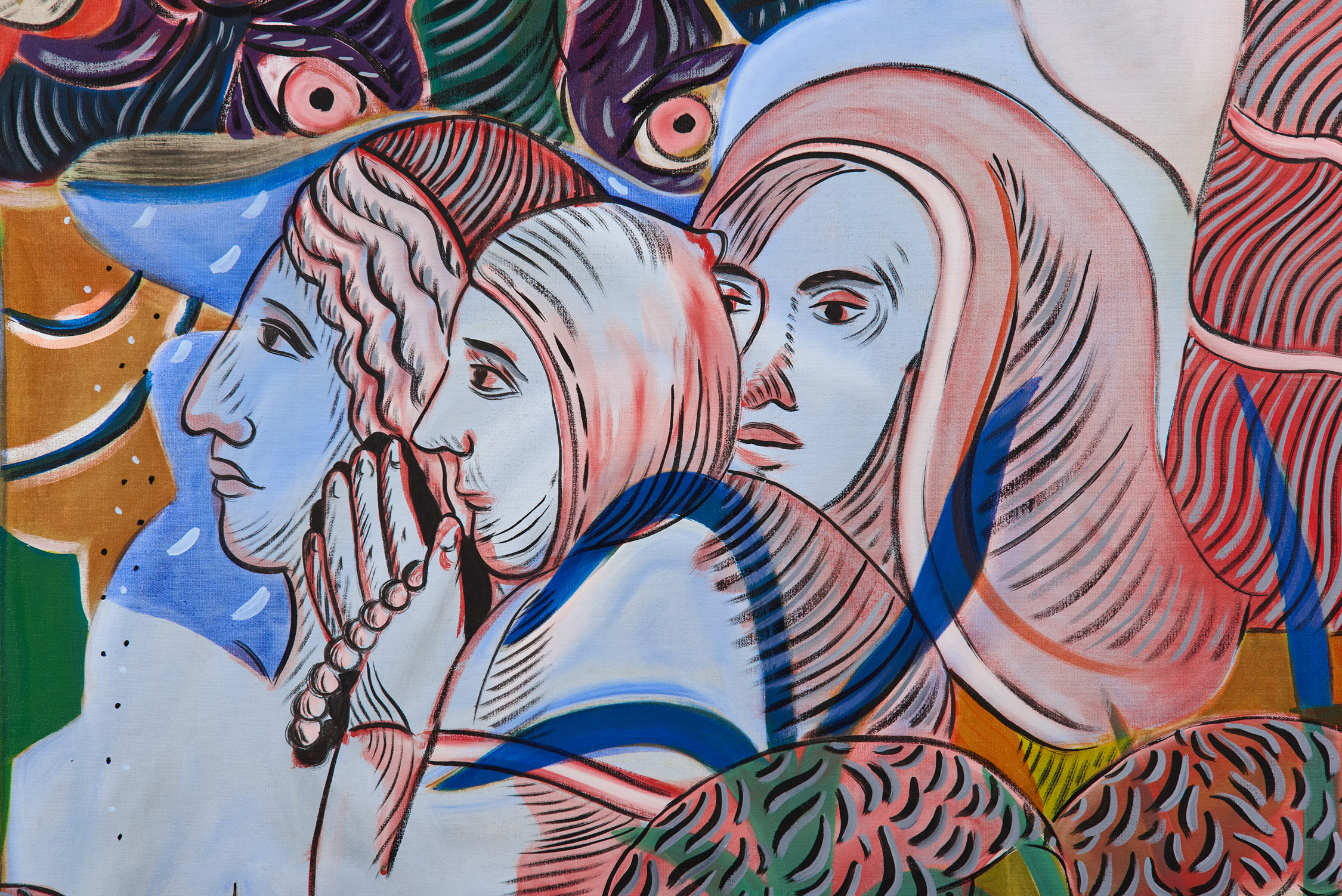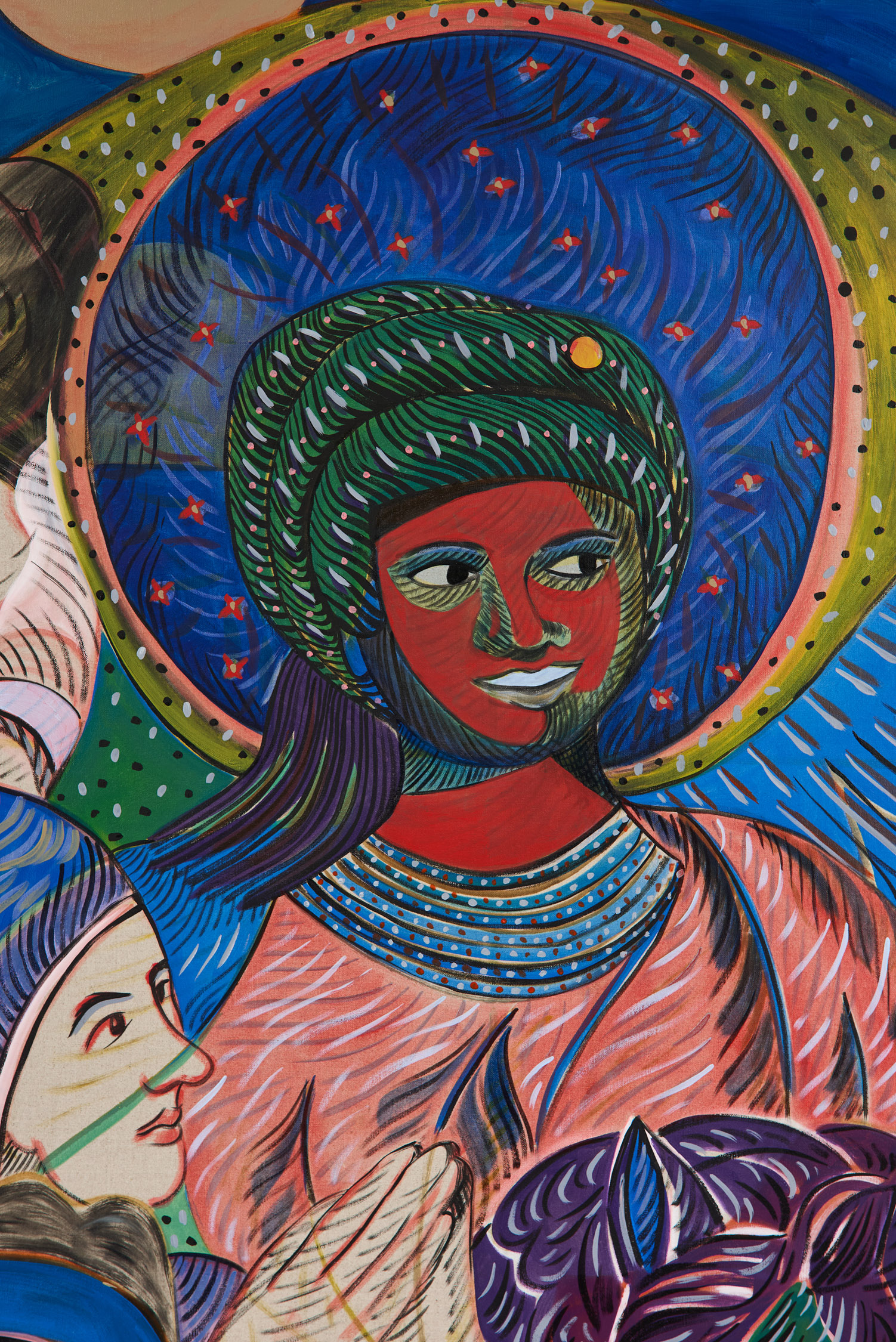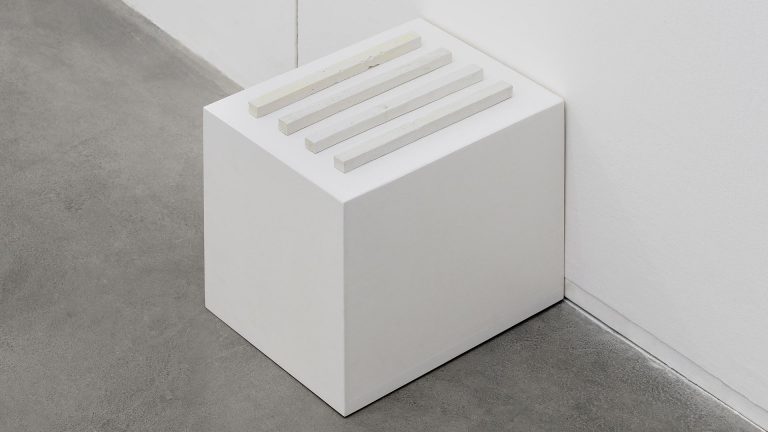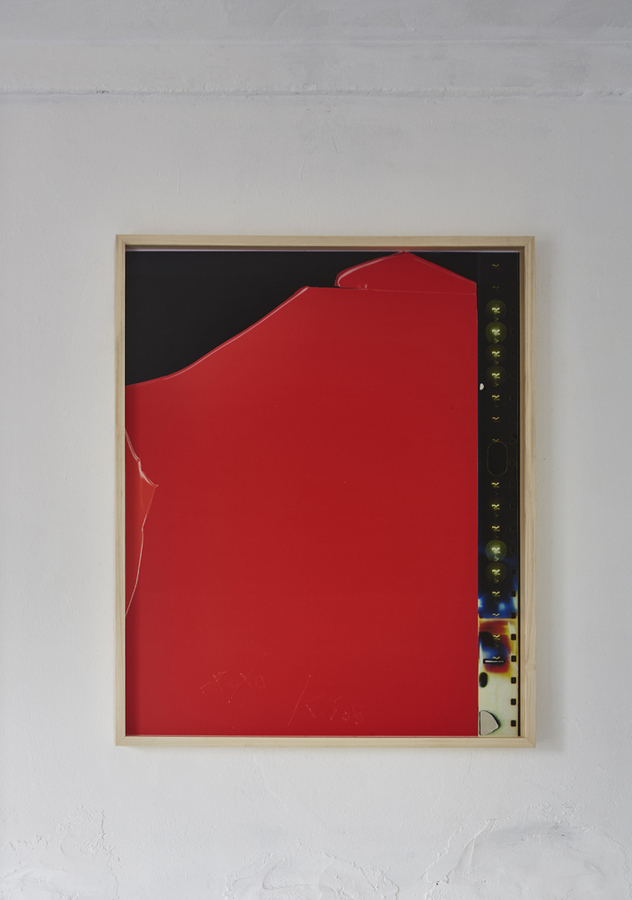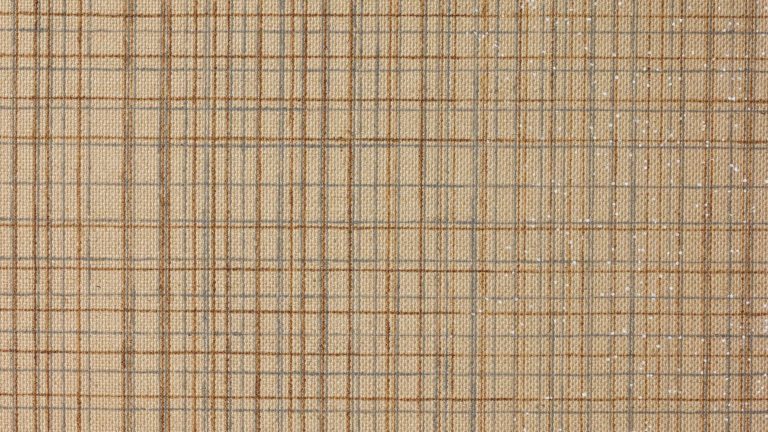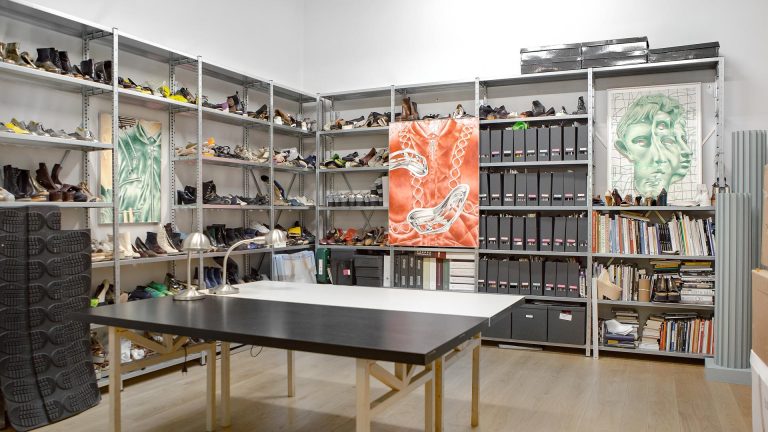Artist: Giulia Mangoni
Exhibition title: Un letto di frasche
Venue: ArtNoble Gallery, Milan, Italy
Date: April 9 – June 6, 2024
Photography: all images copyright and courtesy of the artist and ArtNoble Gallery, Milan
Note: Exhibition catalogue is available here
ArtNoble Gallery is pleased to present Un letto di frasche, a solo exhibition by Giulia Mangoni, in dialogue with material installations by architect Valerio Panella.
For her second solo exhibition at the gallery, Mangoni continues her exploration of the memories associated with the Ciociaria (territory which extends from Rome to Naples), which began with the exhibition ‘Bits and Cream. Metabolizzazione d’Archivio’ in 2021, delving into a magical-realistic vision where the rural world and its characters come to life through material installations and oil paintings. The artist approaches this exhibition with the urgency to ‘synthesize’ the narrative while simultaneously capturing the viewer’s attention with five large canvases, encapsulating fantastical and autobiographical elements. Valerio Panella’s scenographic intervention places materials such as wood, limestone, and straw in their elemental forms within the gallery space, introducing a ‘silent’ reality that leaves no escape routes; these interventions, combined with Mangoni’s exhuberant paintings, accompany the viewer on a dynamic and unique journey.
The leitmotif of the exhibition Un letto di frasche takes inspiration from the 1960s and 1970s, when the Ciociaria became the stage for spaghetti western films due to their proximity to the Cinecittà studios in Rome. It’s amusing to note how these films suddenly gained immense popularity in these areas, thanks to an electrified and excited audience witnessing their own lands merge with the American dream, their valleys transforming into the vast and unknown Nevada, so often seen in Hollywood productions. Suddenly, Rocca Secca becomes the Mexican desert, and something light-years away takes on familiar, homely connotations. Mangoni takes inspiration from this subtle deception and reverses it: in her works, elements and landscapes from other territories are stolen, filtered, and juxtaposed with local landscapes to construct representations that stage a sort of ‘Ciociaro film.’ Instead of taking her own lands and turning them into ‘lands of others’, Mangoni takes images from everywhere and roots them in ‘her’ territory, ironically commenting on the expectation for authenticity connected to the ideal rural landscape.
This play between reality and fiction finds unexpected freedom in her paintings, which not only avoid having a heavy and judgmental gaze towards this dichotomy but somehow protect it, making it an integral part of the modernization process in which we are all called to participate. The theme of magic – always present in Mangoni’s works – suggests a kind of ‘secret vitality’ nestled in this dichotomy: the creative energy of man and nature blend, shaping each other’s forms and colours, as if the relationship between opposites is not only passively accepted but almost sought after as the cradle of these regenerative processes. Thus, Mangoni’s canvases come to life, in dialogue with material elements, and the scenography loses its functional role and becomes part of the creation.
Giulia Mangoni has been exploring the idea of rootedness in relation to a specific territory for almost a decade, focusing on narratives where the periphery, the rural, and the ex-industrial converge to create layered and rich landscapes in which paradoxes are maintained in balance. Valerio Panella studies the relationship between the cultural, and agricultural landscapes, sustainability, and socioeconomic changes, oscillating his practice between architecture, art, and design. He believes it is essential to directly experiment with different forms, languages and materials through his research which is strongly focused on the exploration of natural elements, using different techniques of building and spatial awareness.
Giulia Mangoni is an Italian-Brazilian artist whose practice revolves around the ethics of return; she is interested in creating orchestrated interventions through the lens of painting in order to deconstruct notions of memory and identity linked to specific geographies and decentralized communities. Her work develops through visual methods of personal narration, often the result of a dialogue with several voices, whose influences, relationships, and contributions help to create works that temporarily solidify this process of knowledge and world building in continuous evolution.
Currently, Mangoni continues to deepen her research surrounding ideas of territorial belonging through collaboration with artisans, agronomists and breeders of autochthonous species in the Ciociaria region, and applying these developing methodologies to projects in different regions.
Born in 1991 in Isola del Liri, FR, Mangoni grew up between Italy and Brazil and has now returned to live and work in her hometown. Mangoni has a Foundation Degree in Art & Design from Falmouth University of the Arts (2011), a Bachelor of Painting (Hons) from City & Guilds of London Art School (2014), where she was also a winner of both the Skinner Connard’s Travel Award. Prize and the Chadwick Healey Prize for painting, and an MFA from the SVA Art Practice program in New York City, (2019). Her main exhibitions include: Pittura Italiana Oggi, Triennale Milano, Milan, IT, 2023/24; Pomeriggio Anfibio, Istituto Casa Gramsci, Lunetta11 and ArtNoble gallery, Turin, IT, 2023; Nambur. IUNO, Rome, IT, 2022; Il salmerino viandante, Una Boccata d’Arte, Fondazione Elpis in collaboration with Galleria Continua and Threes Production, San Lorenzo Dorsino, IT, 2022; Geographies of Memory, LAMB Gallery, London, UK, 2022; Bits & Cream. Metabolizzazione d’Archivio, ArtNo-ble gallery, Milan, IT, 2021; Materia Nova, Galleria di Arte Moderna, Rome, IT, 2021; Vivere di paesaggio, APALAZZO Gallery, Brescia, IT, 2021; From the Island of Liri, Dreambox Lab, New York, USA, 2019; Indigestible Feast, Satellite Art Fair, Miami, USA, 2018 e Anything Can Happen at Any Time, SVA Flatiron Gallery, New York, USA, 2018.
